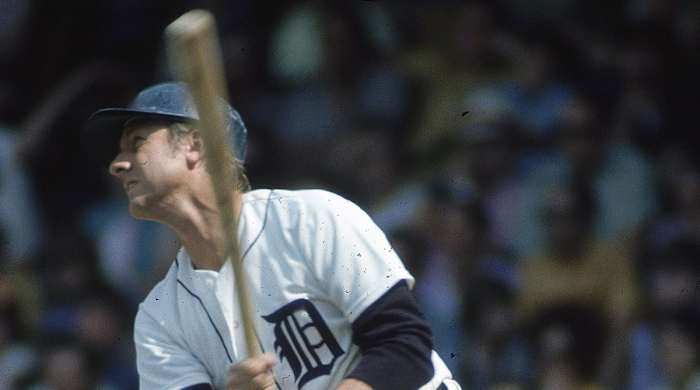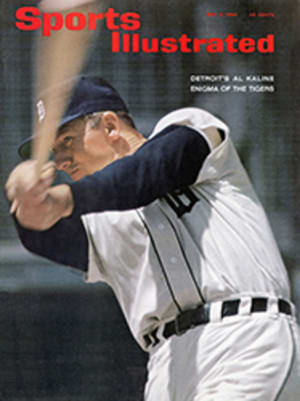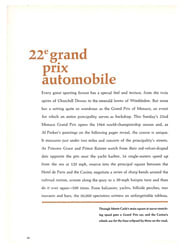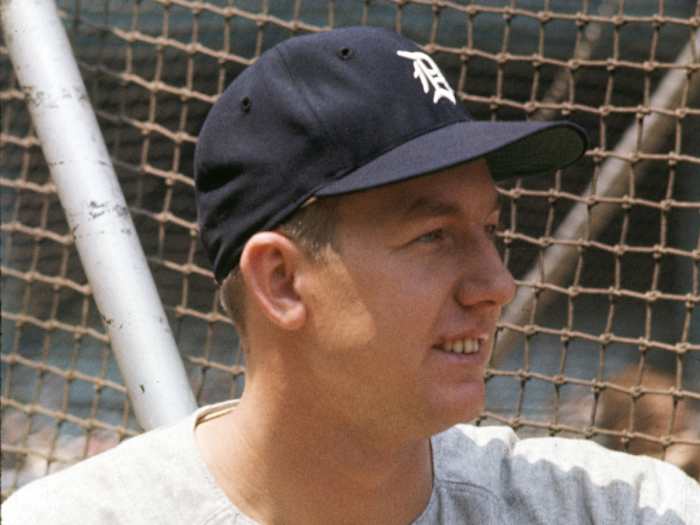THE TORMENTS OF EXCELLENCE
In a world fraught with inconstancies, unpredictabilities and galloping variables, it is a pleasure to report that spring has sprung in the traditional manner in Detroit.The flowers are popping up in Belle Isle park, the automobile plants are booming night and day, and everybody is wondering what's the matter with AlKaline (see cover). Everybody has been wondering what's the matter with AlKaline ever since he made the tactical error of winning the American League batting championship at the age of 20, the youngest player in history to make that mistake. To understand why this is a mistake, one must first understand a baseball truism most recently re-expressed by that skilled practitioner of brushback and typewriter, James Patrick Brosnan, as follows: "Fans want the player to be not what he inherently is but what they think he ought to be."Fans think that anybody who wins the batting title at 20 should win it again four or five or 12 times. Kaline hasn't. Therefore something must be wrong with him.
If there has been any change at all in Detroit's attitude toward the lean and shy outfielder, it is merely quantitative. Of late, the Kaline enigma has been discussed more and more loudly and more and more persistently by college professors and semiskilled seat-spring assemblers, waitresses and grandes dames, by everyone in Detroit who can tell a baseball from a free balloon. As a result of all this discussion, the expectable human reaction has begun to set in. What people cannot figure out they tend to dislike. And Al Kaline, the best all-round ballplayer the Tigers have had since Charley Gehringer, is finding himself disliked. Not long ago he stepped to the plate in a home game to the accompaniment of a Shostakovich symphony of boos and catcalls. One would have thought that Joe DiMaggio had put the old pinstripe back on and returned to hit against the Tigers with the bases loaded; not even Liberace has been booed like that.
While these hostilities were being ventilated, a kindly and gifted sportswriter, long addicted to the wonders of the Tigers and their star right fielder, was stomping about the windswept press box announcing to all who would listen:"As far as I'm concerned, Al Kaline can go take a jump. I've had 10 years of Al Kaline and that's enough!" A few feet away, another expert was collecting his own thoughts about Kaline and coming to a conclusion that he was later to proclaim over the electric radio: "Personally, we feel Kaline should be traded now before his value to the team diminishes even more."The ultimate in non sequiturs was expressed by someone who should know better, and who therefore shall remain nameless. "Maybe the Tigers should trade Kaline," this man observed. "After all, they've never won a pennant with him!" This particular approach to the laws of cause and effect would have made a shambles of the good names of Baron von Richthofen, Haile Selassie and Chuck Klein, but rationality has never been the long suit of the disgruntled baseball fan.
In fact, there are no villains in the Al Kaline story. Not the fans who booed; they only know what they see, and they have been seeing a slumping Kaline. Not the insiders, the habitués of the press box; Kaline has indeed been a difficult subject for them, combining reticence and taciturnity with a seeming indifference and, lately, even rudeness. And certainly nobody can blame Al Kaline himself, the party of the first part, a child who was thrust full-blown into a world in which nothing he ever did was good enough and excellence brought its own torments.
Kaline is one of the last of an almost prehistoric type of ballplayer, the kid who makes it not because of physique but in spite of it. Walk into a baseball clubhouse nowadays and you see The Body Beautiful all around you: smoothly muscled, superbly built young men like Sandy Koufax, Frank Robinson, Mickey Mantle. But not many years ago you would see bandy-legged little guys who make it on gristle and shank, on skills honed in thousands of games on sandlots that no longer exist, on guts and drive and gall.
Al Kaline is not bandy-legged, but neither is he a strong athlete, and he has had to overcome physical limitations that would have driven a lesser man to pack it in long ago. He has always had osteomyelitis, a persistent bone disease, and when he was 8 years old doctors took two inches of bone out of his left foot, leaving jagged scars and permanent deformity. This slowed Kaline down only slightly, and only temporarily. His father, Nicholas, his uncles, Bib and Fred, and his grandfather, Philip, had all been semipro catchers from the Eastern Shore ofMaryland, a place that had spawned major leaguers as Miami Beach spawns gaucherie. One may assume that the first long discussions heard around the family hearth by the infant Albert William Kaline were not about the repeal of the Volstead Act or high protective tariffs. The Kaline family was poor, proud and hungry—no Kaline had ever graduated from high school—and before long the whole clan had decided that little Al was going to be something different.
Down the street from the family's brown-front row house in south Baltimore was a vacant lot(such things are now extinct in cities) where the men of the gas and electric company assembled at lunchtime to sneak in 30 or 40 minutes of softball. After the games Kaline's mother would see the boy, not yet old enough for school, running pell-mell around the bases, all alone, ruining his pants with daring slides to beat throws that were never made. At the ripe old age of 6 he was adjudged skilled enough to be permitted to shag flies and warm up pitchers for the lunchtime frolickers, and within a few years he was welcomed into the game as an equal. At 11 he flung a softball 173 feet 6 inches to set a new elementary school record. The judges did not believe their eyes; so he repeated the feat. Naturally, he became a hard-ball pitcher; the best ballplayer in any neighborhood always seems to be asked to pitch, no matter what his natural position is, e.g., Stan Musial, Babe Ruth. In a league of 10-to-12-year-olds, Kaline's record was 10 and 0. In high school the coach reckoned the boy was too small to make it as a pitcher and too fragile to make it as a second baseman; so he planted Kaline in the outfield. In four years he hit .333, .418, .469 and.488 and made the All-Maryland team each year, a feat last accomplished byCharlie Keller.
By now the Kaline family had staked the boy's whole future on baseball, the way Lower East Side families used to stake a son's future on the violin. On Sundays he would playin two and sometimes three games, with his father and his uncles shuttling him from game to game while he changed uniforms in the car. For one team he was hitting .824 at midseason, but tailed off to .609 at the end. By the time Kaline was signed to a $30,000 bonus-salary arrangement with the Tigers at 18, he had played as much baseball as the average major leaguer plays in five or six seasons, a fact that goes a long way toward explaining why he was able to win the batting championship at 20 and has not won it since: he was at his peak at 20, and the pitchers, looking at the raw young kid of 150 pounds, simply could not bring themselves to admit that he was as good as he was. As Kaline says, "They've been cuter with me ever since."
A childhood like Kaline's may produce a star ballplayer, but it is not guaranteed to produce a barrel of laughs. Says Kaline: "I suffered a lot as a kid playing in all those games. You know how Baltimore is real hot in the summer? When everybody was going on their vacations, going swimming with all the other kids, here I was Sundays playing doubleheaders and all because I knew I wanted to be a ballplayer and my dad always told me, 'You're gonna have to work hard and you're gonna have to suffer if you're gonna be a ballplayer. You're gonna have to play and play all the time.'
"There was a couple times when I told my dad I wasn't gonna play Sunday, I was gonna go down to the beach with my girl or with a bunch of the guys to go swimming. And he says, 'Now look, like I told you in the beginning when you agreed to play for these people, they're gonna be counting on you, so if you're not gonna play tell 'em to tear your contract up.' So I would go play, but it was these thing she did to me that showed me the right way and pushed me the right way."
Kaline was a dutiful son; when the Tigers thrust something in the neighborhood of $15,000 in cold cash on him (with $15,000 to come later in salary), he turned every penny of it over to. his father, who was working in a broom factory, and his mother, who was scrubbing floors. The mortgage was paid off on the house, Mrs. Kaline's failing eyesight was saved by an operation, and young Al drove up to ConnieMack Stadium to take his maiden cut as a major leaguer. He flied out to center on the first pitch, and was so nervous that he has no memory of going to the plate, swinging or returning to the dugout. Within a few years Ted Williams was saying: "There's a hitter. In my book he's the greatest right-handed hitter in the league. There's no telling how far the kid could go." Said a well-known manager: "This fellow is amazing. You ask yourself four questions. Can he throw? And the answer is yes. Can he field the ball? And you answer yes. Is he active on the bases? Yes, you'd have to say yes. And then, can he drive in the runs? The real test. And again you say yes. So he is an amazing fellow."
He was, in his early years in the majors, more amazing than even Casey Stengel realized, and at the same time he did everything with fluid ease. Dale Mitchell rapped a ball into right field and Kaline barely missed a sprawling shoestring catch. The ball rolled a few feet away and Mitchell scooted for second. Kaline threw him out from a sitting position. In a game against the White Sox, when he was 19years old, Kaline threw out Fred Marsh trying to score from second on a single,Minnie Minoso trying to stretch a single into a double and Chico Carrasquel trying to go from first to third on another single. The only people who believed it were those in the ball park, and they were not sure. At YankeeStadium, with the Tigers ahead by one run and the Yankees threatening with two outs and two on in the last of the ninth, Mickey Mantle hit a ball so hard and so far that Mel Allen's broadcasting assistant whooped, "The Yankees win five to four!" as he counted the base runners coming across. In the Tiger clubhouse the equipment man angrily flipped the radio off and waited for theTigers to mope in. They came in yelling and laughing. Kaline had raced to the auxiliary scoreboard, leaped and twisted high in the air, supported himself against the scoreboard with his bare hand and caught the ball backhanded to end the game.
But the question, in his first few years, was not whether he was a good enough fielder; everybody knew he was that. "I was there because I was a fielder," Kaline says."That's what kept me in the league. The question was: Did I have enough bat?"
His first season as a regular, 1955, answered that question. At .340, he out-hit Mickey Mantle by 34 points and Willie Mays by 21. Among other feats of batsmanship that year, he made four hits in five at bats one day against the Kansas City A's; three of the hits were home runs and two of the home runs came in a single inning, a feat accomplished by only five other American League players. He was compared to Ty Cobb, and after that everything was bound to be Bridgeport.
Looking back, Kaline cannot help feeling resentment. "The worst thing that happened to me in the big leagues was the start I had. This put the pressure on me. Everybody said this guy's another Ty Cobb, another Joe DiMaggio. How much pressure can you take? What they didn't know is I'm not that good a hitter. They kept sayingI do everything with ease. But it isn't that way. I have to work as hard if not harder than anybody in the league. I'm in spring training a week early every year. I've worked with a heavy bat in the winter, swinging it against a big bag. I've squeezed rubber balls all winter long to strengthen my hands. I've lifted weights, done push-ups, but my hitting is all a matter of timing. I don't have the kind of strength that Mantle or Mays have, where they can befooled on a pitch and still get a good piece of the ball. I've got to have my timing down perfect or I'm finished. Now you take a hitter like me, with all the concentration and effort I have to put into it—I'm not crying about it, it's just a fact—and imagine how it feels to be compared to Cobb. He was the greatest ballplayer that ever lived. To say that I'm like him is the most foolish thing that anybody can make a comparison on. Do you realize there's old people that come to Tiger Stadium and they saw Cobb play ball, and they look at me and they say how can I be as good as Cobb? They threw all this pressure on my shoulders and I don't think it's justified and I don't think it's fair to compare anybody with Cobb. I'll tell you something else: I'm not in the same class with players like Mays or Musial or Henry Aaron, either. Their records over the last five seasons are much better than mine."
In the first few years after he won the batting championship, Kaline went into frequent depressions over his inability to give the fans what he knew they expected. He would come into the clubhouse after a game and slump in front of his locker, speaking to no one. "But I didn't really sulk, the way the newspapermen said I did," he claims. "I was just quiet, and when a newspaperman came up to me and said, 'Nice game,' or something like that, I'd just say, 'Thank you.' I would never prolong the conversation, and the guys who didn't know me would say, 'Look at this stuck-up kid.' But it was just my way. I don't talk much. I don't like to make people mad at me, and if you talk too much you're gonna put your foot in your mouth sooner or later."
On top of these pressures, the front office began to apply the screws to Kaline. "They told me to be more colorful, that I could bring more people into the ball park if I was more colorful. But how could I do that? I could jump up and down on the field and make an ass out of myself arguing with umpires, but I'm not made up that way. I could make easy catches look hard, but I'm not made that way either."
The result of all these subtle difficulties is The Al Kaline Problem, the certain harbinger of spring in Detroit. But is there a genuine problem or is it ersatz? Charley Dressen votes for ersatz. "He's not hitting now," says the cherubic little manager and gourmet, "but what does that mean? Nothing When a man is an established hitter like Kaline, you know what he's gonna do. The pitchers are getting him out now, but later on in the season somebody's gonna suffer."
It is true that Kaline at 29 seems overplayed, tired both physically and emotionally. He does not have a rapport with Dressen; although each publicly equates the other withAlexander of Macedon, there is antipathy underneath, and it will be a long time healing. Kaline was one of three or four players who complained vehemently about the firing of Manager Bob Scheffing last year. "He made me a good ballplayer," Kaline says, "and I was really devoted to him."Scheffing did not make Kaline a good ballplayer; that job was accomplished years before by Nick Kaline and Al's uncles, but Kaline's veneration of Scheffing is nonetheless real.
But the main difference in Al Kaline is that the new 1964 model does not seem to be having any fun. To be sure, he claims that he is—"when it gets to be no fun you'll know it, because I won't be playing anymore." Not every man is gifted with the ability to know himself, and Kaline does not appear to be one of them. You might suppose that a man with a .309 lifetime batting average (same asMantle's) and a place in the record books alongside Babe Ruth and a$62,000-a-year salary and plenty of outside income would be having the time of his life, an orgy of joy. But talking to Kaline is like making funeral arrangements. In one breath he provides all the proper, time-honored remarks:"Detroit fans have really been good to me.... I think that Charley Dressen knows more about baseball than any manager I've ever had.... I owe everything to baseball. Without it, I'd probably be a bum today." But his more meaningful comments are made between the lines, almost sotto voce: "The owners want you to eat baseball, drink baseball, think baseball. It's too much to expect.... The season should be cut in half. Double-headers should be banned. It takes me three days to get over a doubleheader.... Spring training is overrated. I'll admit I'm bored with it...." He sounds, at times, like an old lady with sore feet, and, in fact, he is a young man with sore feet.Very sore feet. No one except Kaline himself will ever know the agonies that have accompanied his long career as an athletic cripple, mostly because he has kept his mouth shut about it. When the doctors operated on him, they left him with a set of sharply swept-back toes on his left foot. Only two of those toes touch the ground when he walks, which has forced him to develop a special running style: on the heel and toes of his right foot and on the side of his left foot. The fact that he gets to line drives with the style and skill of aMantle or Mays is one of the athletic miracles of the ages. All Kaline will admit publicly is that his foot sometimes hurts him—"it's like a toothache in the foot." But there is a clearly discernible difference in his running as the game goes on. The Kaline who lopes out to his right-field position in the first inning runs almost normally; the Kaline who comes in after the last out is in pain and favoring the left foot. He is forever having his foot rubbed by Trainer Jack Homel to restore the circulation and relieve the pain. On top of that, he has suffered more than the average number of injuries, among them depressed fractures of both cheekbones, two beanings and a broken collarbone.Baseball has not been a frolic through sylvan glades for Al Kaline, and if a lot of Detroiters do not know it, at least one person does: General Manager JimCampbell of the Tigers. "Al Kaline has had more reason to jake it than almost any ballplayer I know," says Campbell, "but I have never seen him give less than everything he had. That's the way he learned to play baseball, and that's the only way he knows how."
And what about all the suggestions that The Al Kaline Problem be solved by trading him off while he is still a valuable commodity? "Well, I'll tell you," saysCampbell. "I would consider it. Yes, sir, I would. If the Giants would offer me Mays and Marichal and Cepeda for Kaline, I would have to give it some consideration." In the meantime, Campbell and Charley Dressen and the good people of Detroit will have to live with their problem. With a couple more problems like Al Kaline, the Tigers would be the Yankees.




